Depth first Search or Depth first traversal is a recursive algorithm for searching all the vertices of a graph or tree data structure. Traversal means visiting all the nodes of a graph.
Depth First Search Algorithm
A standard DFS implementation puts each vertex of the graph into one of two categories:
- Visited
- Not Visited
The purpose of the algorithm is to mark each vertex as visited while avoiding cycles.
The DFS algorithm works as follows:
- Start by putting any one of the graph's vertices on top of a stack.
- Take the top item of the stack and add it to the visited list.
- Create a list of that vertex's adjacent nodes. Add the ones which aren't in the visited list to the top of the stack.
- Keep repeating steps 2 and 3 until the stack is empty.
Depth First Search Example
Let's see how the Depth First Search algorithm works with an example. We use an undirected graph with 5 vertices.
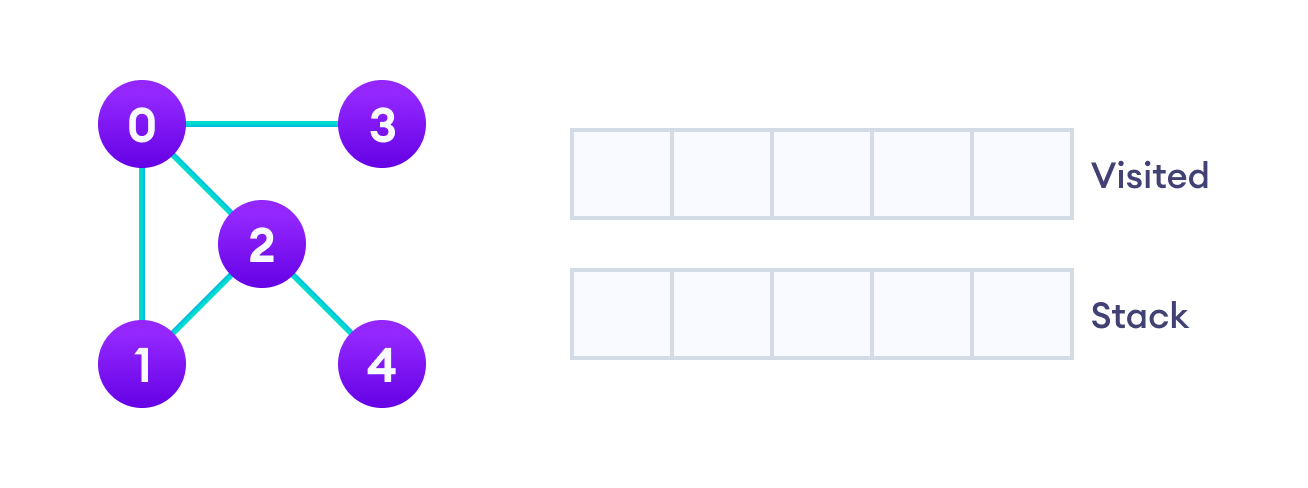
We start from vertex 0, the DFS algorithm starts by putting it in the Visited list and putting all its adjacent vertices in the stack.
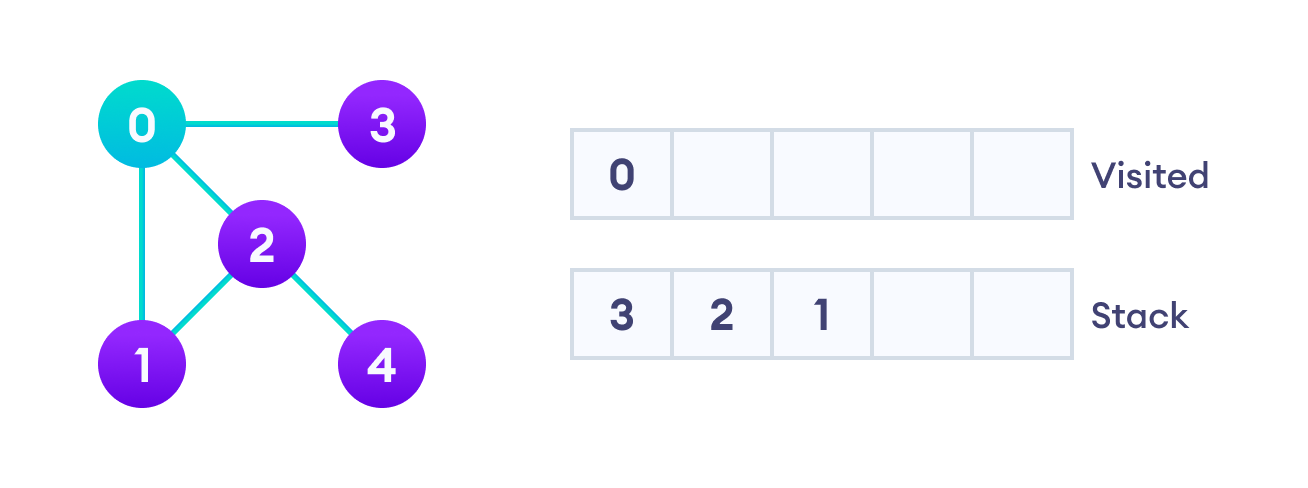
Next, we visit the element at the top of stack i.e. 1 and go to its adjacent nodes. Since 0 has already been visited, we visit 2 instead.
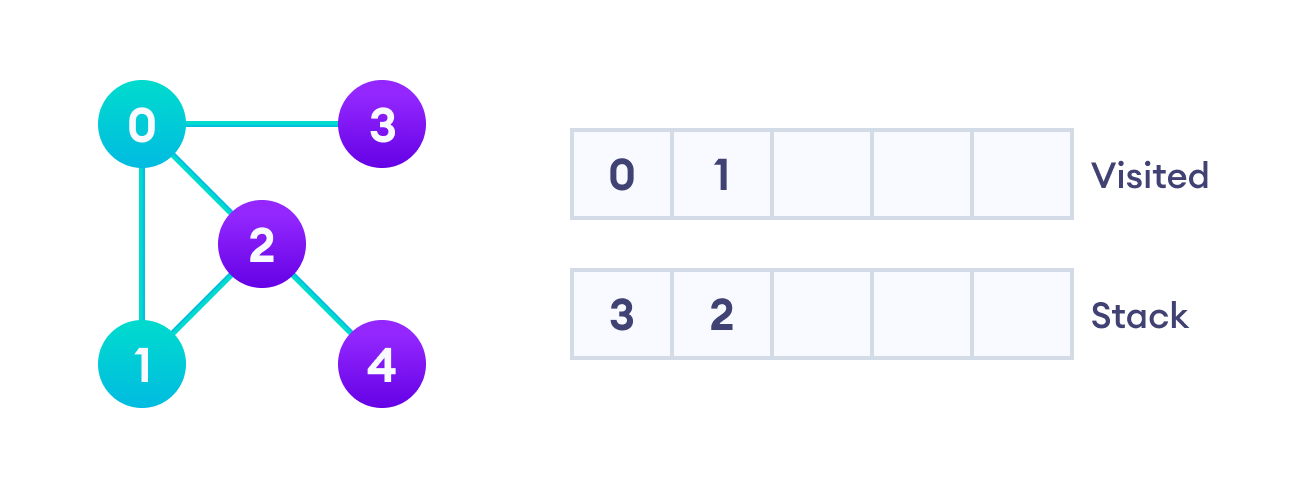
Vertex 2 has an unvisited adjacent vertex in 4, so we add that to the top of the stack and visit it.
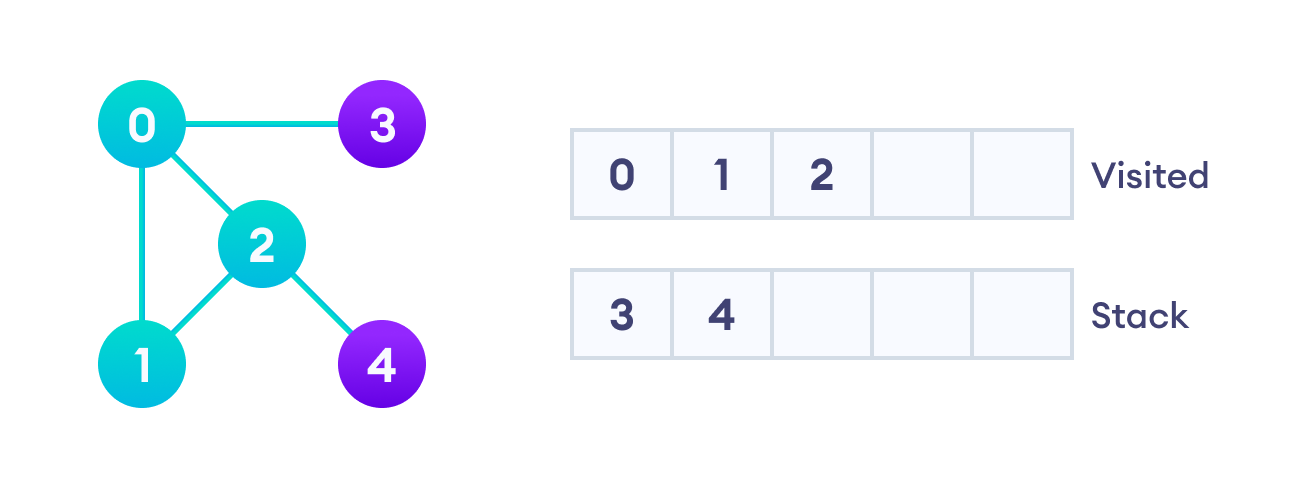
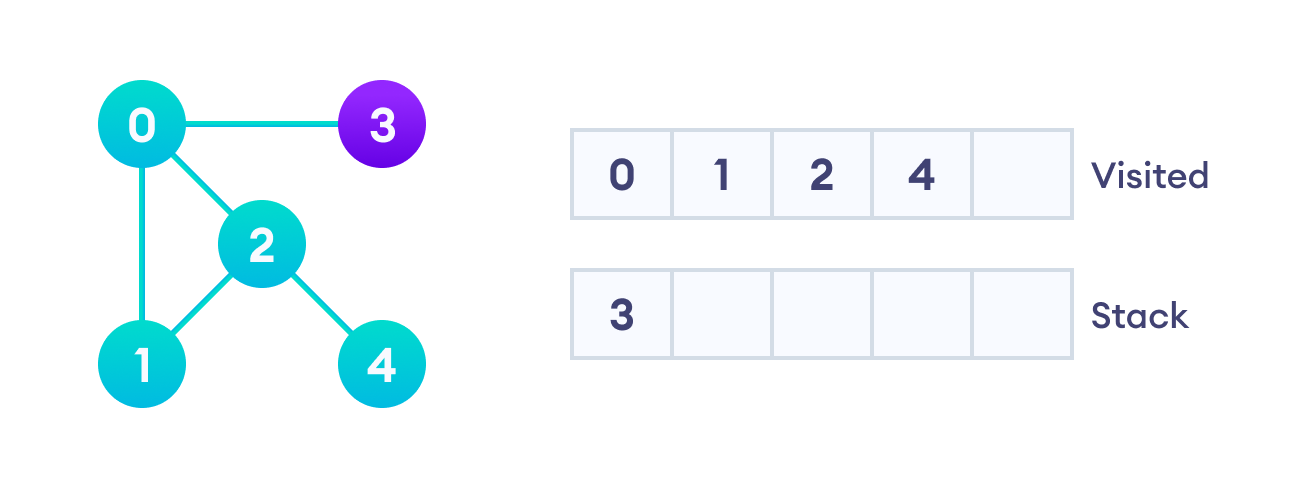
After we visit the last element 3, it doesn't have any unvisited adjacent nodes, so we have completed the Depth First Traversal of the graph.

DFS Pseudocode (recursive implementation)
The pseudocode for DFS is shown below. In the init() function, notice that we run the DFS function on every node. This is because the graph might have two different disconnected parts so to make sure that we cover every vertex, we can also run the DFS algorithm on every node.
DFS(G, u)
u.visited = true
for each v ∈ G.Adj[u]
if v.visited == false
DFS(G,v)
init() {
For each u ∈ G
u.visited = false
For each u ∈ G
DFS(G, u)
}
DFS Implementation in Python, Java and C/C++
The code for the Depth First Search Algorithm with an example is shown below. The code has been simplified so that we can focus on the algorithm rather than other details.
DFS Visualization: Don't just read about DFS, watch it happen live. See how each line of the algorithm works step-by-step with our new DSA visualizer. Try it yourself!
# DFS algorithm in Python
# DFS algorithm
def dfs(graph, start, visited=None):
if visited is None:
visited = set()
visited.add(start)
print(start)
for next in graph[start] - visited:
dfs(graph, next, visited)
return visited
graph = {'0': set(['1', '2']),
'1': set(['0', '3', '4']),
'2': set(['0']),
'3': set(['1']),
'4': set(['2', '3'])}
dfs(graph, '0')
// DFS algorithm in Java
import java.util.*;
class Graph {
private LinkedList<Integer> adjLists[];
private boolean visited[];
// Graph creation
Graph(int vertices) {
adjLists = new LinkedList[vertices];
visited = new boolean[vertices];
for (int i = 0; i < vertices; i++)
adjLists[i] = new LinkedList<Integer>();
}
// Add edges
void addEdge(int src, int dest) {
adjLists[src].add(dest);
}
// DFS algorithm
void DFS(int vertex) {
visited[vertex] = true;
System.out.print(vertex + " ");
Iterator<Integer> ite = adjLists[vertex].listIterator();
while (ite.hasNext()) {
int adj = ite.next();
if (!visited[adj])
DFS(adj);
}
}
public static void main(String args[]) {
Graph g = new Graph(4);
g.addEdge(0, 1);
g.addEdge(0, 2);
g.addEdge(1, 2);
g.addEdge(2, 3);
System.out.println("Following is Depth First Traversal");
g.DFS(2);
}
}
// DFS algorithm in C
#include <stdio.h>
#include <stdlib.h>
struct node {
int vertex;
struct node* next;
};
struct node* createNode(int v);
struct Graph {
int numVertices;
int* visited;
// We need int** to store a two dimensional array.
// Similary, we need struct node** to store an array of Linked lists
struct node** adjLists;
};
// DFS algo
void DFS(struct Graph* graph, int vertex) {
struct node* adjList = graph->adjLists[vertex];
struct node* temp = adjList;
graph->visited[vertex] = 1;
printf("Visited %d \n", vertex);
while (temp != NULL) {
int connectedVertex = temp->vertex;
if (graph->visited[connectedVertex] == 0) {
DFS(graph, connectedVertex);
}
temp = temp->next;
}
}
// Create a node
struct node* createNode(int v) {
struct node* newNode = malloc(sizeof(struct node));
newNode->vertex = v;
newNode->next = NULL;
return newNode;
}
// Create graph
struct Graph* createGraph(int vertices) {
struct Graph* graph = malloc(sizeof(struct Graph));
graph->numVertices = vertices;
graph->adjLists = malloc(vertices * sizeof(struct node*));
graph->visited = malloc(vertices * sizeof(int));
int i;
for (i = 0; i < vertices; i++) {
graph->adjLists[i] = NULL;
graph->visited[i] = 0;
}
return graph;
}
// Add edge
void addEdge(struct Graph* graph, int src, int dest) {
// Add edge from src to dest
struct node* newNode = createNode(dest);
newNode->next = graph->adjLists[src];
graph->adjLists[src] = newNode;
// Add edge from dest to src
newNode = createNode(src);
newNode->next = graph->adjLists[dest];
graph->adjLists[dest] = newNode;
}
// Print the graph
void printGraph(struct Graph* graph) {
int v;
for (v = 0; v < graph->numVertices; v++) {
struct node* temp = graph->adjLists[v];
printf("\n Adjacency list of vertex %d\n ", v);
while (temp) {
printf("%d -> ", temp->vertex);
temp = temp->next;
}
printf("\n");
}
}
int main() {
struct Graph* graph = createGraph(4);
addEdge(graph, 0, 1);
addEdge(graph, 0, 2);
addEdge(graph, 1, 2);
addEdge(graph, 2, 3);
printGraph(graph);
DFS(graph, 2);
return 0;
}
// DFS algorithm in C++
#include <iostream>
#include <list>
using namespace std;
class Graph {
int numVertices;
list<int> *adjLists;
bool *visited;
public:
Graph(int V);
void addEdge(int src, int dest);
void DFS(int vertex);
};
// Initialize graph
Graph::Graph(int vertices) {
numVertices = vertices;
adjLists = new list<int>[vertices];
visited = new bool[vertices];
}
// Add edges
void Graph::addEdge(int src, int dest) {
adjLists[src].push_front(dest);
}
// DFS algorithm
void Graph::DFS(int vertex) {
visited[vertex] = true;
list<int> adjList = adjLists[vertex];
cout << vertex << " ";
list<int>::iterator i;
for (i = adjList.begin(); i != adjList.end(); ++i)
if (!visited[*i])
DFS(*i);
}
int main() {
Graph g(4);
g.addEdge(0, 1);
g.addEdge(0, 2);
g.addEdge(1, 2);
g.addEdge(2, 3);
g.DFS(2);
return 0;
}
Complexity of Depth First Search
The time complexity of the DFS algorithm is represented in the form of O(V + E), where V is the number of nodes and E is the number of edges.
The space complexity of the algorithm is O(V).
Application of DFS Algorithm
- For finding the path
- To test if the graph is bipartite
- For finding the strongly connected components of a graph
- For detecting cycles in a graph
